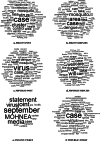Temporal and textual analysis of social media on collective discourses during the Zika virus pandemic
- PMID: 32471495
- PMCID: PMC7257143
- DOI: 10.1186/s12889-020-08923-y
Temporal and textual analysis of social media on collective discourses during the Zika virus pandemic
Abstract
Background: While existing studies have investigated the role of social media on health-related communication, little is known about the potential differences between different users groups on different social media platforms in responses to a health event. This study sets out to explore the online discourse of governmental authorities and the public in Singapore during the recent Zika pandemic in 2016.
Methods: Social media data were extracted from Facebook and Twitter using retroactive keyword sourcing of the word "Zika" to search for posts and a location filter of "Singapore". Government posts, public posts, and replies to these original posts were included in the temporal and textual analysis.
Results: Overall, Facebook contained more government and individual content whereas Twitter had more content from news media accounts. Though the relative volume of Zika content from different data sources paralleled the peaks and troughs of Zika activities across time, discourses from different data sources differed in their temporal patterns, such that the public discourse died down faster than the government discourse after the outbreak was declared. In addition, the content of discourses differed among data sources. While government discourse included factual information of the disease, public discourse contained more elements of care such as worry about the risks to pregnant women, and elements of community such as well-wishes to each other.
Conclusions: Our study demonstrates the temporal and content differences between user groups and social media platforms in social media conversations during the Zika pandemic. It suggests that future research should examine the collective discourse of a health event by investigating social media discourses within varied sources rather than focusing on a singular social media platform and by one particular type of users.
Keywords: Facebook; Health communication; Public health; Social media; Twitter; Zika.
Conflict of interest statement
The authors declare that we have no competing interests.
Figures




Similar articles
-
What's buzzing on your feed? Health authorities' use of Facebook to combat Zika in Singapore.J Am Med Inform Assoc. 2017 Nov 1;24(6):1155-1159. doi: 10.1093/jamia/ocx028. J Am Med Inform Assoc. 2017. PMID: 28449047 Free PMC article.
-
Strategic Uses of Facebook in Zika Outbreak Communication: Implications for the Crisis and Emergency Risk Communication Model.Int J Environ Res Public Health. 2018 Sep 10;15(9):1974. doi: 10.3390/ijerph15091974. Int J Environ Res Public Health. 2018. PMID: 30201929 Free PMC article.
-
Public sentiment and discourse about Zika virus on Instagram.Public Health. 2017 Sep;150:170-175. doi: 10.1016/j.puhe.2017.07.015. Epub 2017 Aug 12. Public Health. 2017. PMID: 28806618 Review.
-
Local chatter or international buzz? Language differences on posts about Zika research on Twitter and Facebook.PLoS One. 2018 Jan 5;13(1):e0190482. doi: 10.1371/journal.pone.0190482. eCollection 2018. PLoS One. 2018. PMID: 29304110 Free PMC article.
-
Emergency Risk Communication: Lessons Learned from a Rapid Review of Recent Gray Literature on Ebola, Zika, and Yellow Fever.Health Commun. 2019 Apr;34(4):437-455. doi: 10.1080/10410236.2017.1405488. Epub 2018 Mar 20. Health Commun. 2019. PMID: 29558199 Review.
Cited by
-
Facebook and mosquito-borne disease outbreaks: An analysis of public responses to federal health agencies' posts about dengue and Zika in 2016.PLOS Glob Public Health. 2022 Sep 12;2(9):e0000977. doi: 10.1371/journal.pgph.0000977. eCollection 2022. PLOS Glob Public Health. 2022. PMID: 36962780 Free PMC article.
-
Network Structure and Community Evolution Online: Behavioral and Emotional Changes in Response to COVID-19.Front Public Health. 2022 Jan 11;9:813234. doi: 10.3389/fpubh.2021.813234. eCollection 2021. Front Public Health. 2022. PMID: 35087790 Free PMC article.
-
An Environmental Uncertainty Perception Framework for Misinformation Detection and Spread Prediction in the COVID-19 Pandemic: Artificial Intelligence Approach.JMIR AI. 2024 Jan 29;3:e47240. doi: 10.2196/47240. JMIR AI. 2024. PMID: 38875583 Free PMC article.
-
Learning about COVID-19: a qualitative interview study of Australians' use of information sources.BMC Public Health. 2021 Apr 7;21(1):662. doi: 10.1186/s12889-021-10743-7. BMC Public Health. 2021. PMID: 33823843 Free PMC article.
-
Deconstructing agency in the G20 leaders' declarations in the last decade: A corpus-assisted discourse study.Heliyon. 2022 Dec 19;8(12):e12439. doi: 10.1016/j.heliyon.2022.e12439. eCollection 2022 Dec. Heliyon. 2022. PMID: 36590524 Free PMC article.
References
-
- Kaplan AM, Haenlein M. Users of the world, unite! The challenges and opportunities of social media. Bus Horiz. 2010;53:59–68. doi: 10.1016/j.bushor.2009.09.003. - DOI
-
- Rutsaert P, Regan Á, Pieniak Z, McConnon Á, Moss A, Wall P, Verbeke W. The use of social media in food risk and benefit communication. Trends Food Sci Technol. 2013;30:84–91. doi: 10.1016/j.tifs.2012.10.006. - DOI
-
- Winer RS. New communications approaches in marketing: issues and research directions. J Interact Mark. 2009;23:108–117. doi: 10.1016/j.intmar.2009.02.004. - DOI
MeSH terms
Grants and funding
LinkOut - more resources
Full Text Sources
Medical

